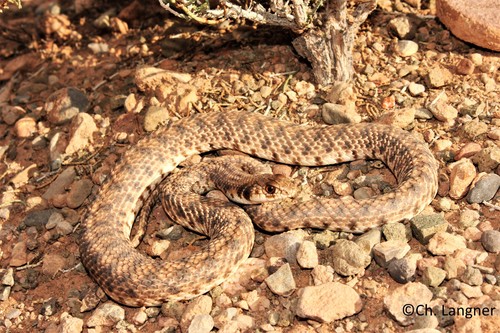
Hooded Malpolon
The Moila snake, with its slender form and sandy hues, thrives in arid landscapes of North Africa and the Middle East. A diurnal predator, it skillfully hunts lizards and small mammals, contributing to ecosystem balance. Its unique head shape and mild venom add intrigue to this desert dweller.
Least Concern
Conservation Status
Stable
Population Trend
Characteristics
Malpolon moilensis, commonly known as the Moila snake, is a species of mildly venomous snake found in arid and semi-arid regions across North Africa and the Middle East. It is known for its slender body, sandy coloration, and distinctive head shape. This diurnal hunter primarily feeds on lizards and small mammals, playing a crucial role in controlling local pest populations.
Distribution Range of the Hooded Malpolon
Malpolon moilensis, commonly known as the Desert Racer, is native to North Africa and parts of the Middle East. Its geographical distribution includes countries like Egypt, Libya, Algeria, Tunisia, Morocco, Israel, Jordan, Saudi Arabia, and Yemen. Additionally, it is found in some parts of the Arabian Peninsula.
Hooded Malpolon's Habitat
Environmental Conditions
Malpolon moilensis typically inhabits arid and semi-arid regions, characterized by hot, dry climates. The environmental conditions of its habitat include sparse vegetation, sandy or rocky substrates, and extreme temperature variations between day and night.
Ecological Niche
The Desert Racer is well-adapted to desert environments, where it occupies a niche as a diurnal predator. It preys on small mammals, birds, and lizards, often using its speed and agility to catch its prey. It is also known for its ability to thrive in environments with limited water resources, obtaining moisture from its prey and the environment.
Copyright @ Nature Style Limited. All Rights Reserved.
 English
English